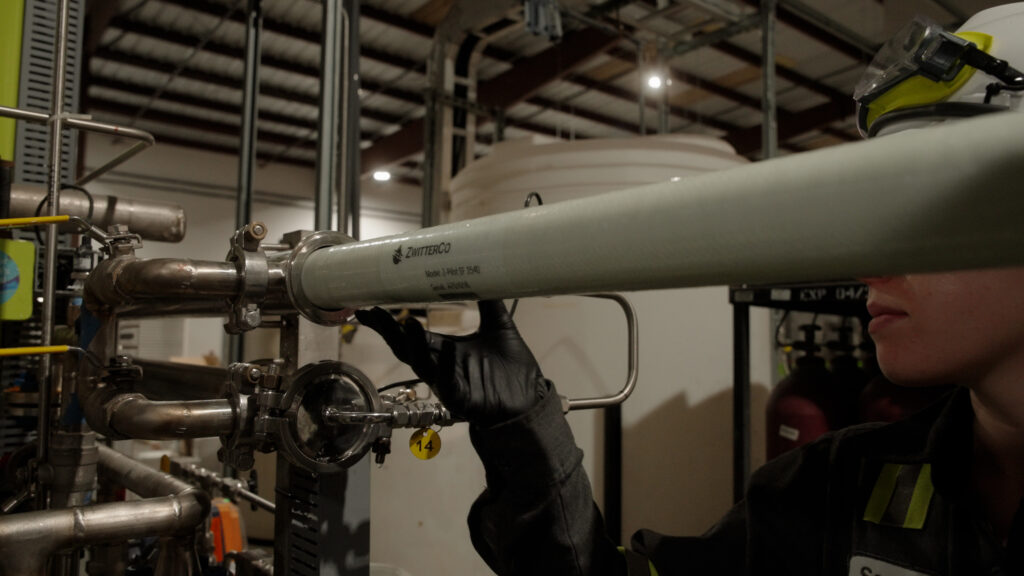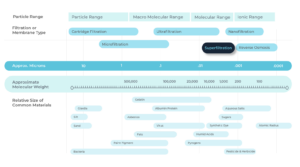When considering which type of membrane to use, it can be easy to fall into the trap of thinking “inside the box” of established membrane categories. Salt rejection, molecular weight cut-offs, pore sizes, and flow rates are almost universally used to categorize membranes, but as membrane applications expand into more challenging separations, it’s worth considering other factors. Some of these difficult separations call for membranes that don’t fit neatly into those traditional categories.
Current Membrane Types
In the world of filtration, categories are generally based on the particle size or type of solute rejected. A typical filtration chart might show the following particle ranges, by approximate micron size: particulate range, macro molecular range, molecular range, and ionic range. The filtration or membrane classes currently used to indicate rejection capabilities would include now-household names such as cartridge filtration, microfiltration (MF), ultrafiltration (UF), nanofiltration (NF), and reverse osmosis (RO).
When focusing on membranes, it is common to think about MF and UF for removing components based on size exclusion, and RO and NF for rejecting salts and dissolved ions. However, not all membranes fall into these tidy categories; some blur the lines, especially when it comes to separating dissolved organic compounds.
This is why ZwitterCo has defined a new category of membrane filtration: superfiltration (SF)—a groundbreaking new class of filtration that strategically bridges the gap between ultrafiltration and nanofiltration.
Superfiltration: A Whole New Category
As the challenges of water scarcity intensify, advancements in material science have begun to push the boundaries of what’s possible in water treatment technologies. With membranes continuing to advance, they don’t always fit perfectly into the traditional categories of membrane filtration.
Coined by ZwitterCo as a new category of filtration that sits between ultrafiltration and nanofiltration, SF takes the best of both categories and offers enhanced treatment capabilities, allowing for more precise and efficient removal of contaminants. This progress is essential to the development of better water treatment methods needed to meet the increasing global demand for clean water.
What is Zwitterionic SF?
ZwitterCo SF membranes are among those that fall into the new category. The SF membranes possess a Molecular Weight Cut-Off (MWCO) ranging from 500 to 3,500 Daltons and 1kDa, being particularly effective against organic contaminants. The key to the advanced capabilities lies in the use of zwitterions. Unlike traditional filtration products, ZwitterCo SF membranes are built with zwitterions that attract water while seamlessly repelling organic compounds (like proteins, fats, and oils) that normally stick to membranes and ruin their filtration capacity.
The result? ZwitterCo membranes are uniquely immune to irreversible organic fouling.
Using zwitterionic technology, ZwitterCo SF membranes not only refine the filtration process but also significantly expand the potential for water availability, catering to both public and private uses.
Benefits of ZwitterCo SF
ZwitterCo SF membranes offer a range of advantages that set them apart in the water treatment industry— changing the game by going where no membrane has gone before. Some of the benefits include:
1. High Organic / Low Salt Rejection
Superfiltration membranes demonstrate high NF-like organic rejection and low UF-like salt rejection. This behavior allows for SF membranes to operate at low pressures, as they are not fighting against the osmotic pressure of the wastewater, resulting in a low-energy operation that acts as the best possible pretreatment to downstream processes, such as RO.
ZwitterCo SF can handle unprecedented levels of Fats, Oils, and Grease (FOG) up to 5% as well as other hard-to-treat organics, fully recovering with a simple maintenance wash.
2. Organic Fouling Resistant
ZwitterCo SF membranes have a high resistance to fouling due to the zwitterionic technology, which significantly reduces maintenance frequency and prolongs the membrane lifespan, making water reuse attainable and cost-effective—even in the most challenging wastewater conditions.
3. Designed for Extremes
Superfiltration membranes can handle >1MM ppm-hours of chlorine, peracetic acid, aqueous ammonia, and other cleaning agents, showing unmatched chemical resilience.
4. Suspended Solids Removal
ZwitterCo SF removes dissolved and suspended compounds larger than 1 nanometer/1 kDa, including FOG, TSS, turbidity, proteins, polysaccharides, and humic acids, providing ideal feedwater for reverse osmosis and thorough wastewater purification.
Where Can You Use SF?
Superfiltration membranes are highly adaptable and ideal for a wide range of applications. In industrial settings, ZwitterCo SF membranes play a crucial role in attainable sustainable water reuse and are particularly effective in wastewater treatment.
In the food and beverage industry, ZwitterCo SF membranes are especially useful—handling levels of FOG up to 5% in operations like poultry processing. Additionally, they are ideal for managing manure digestate and food waste digestate in agricultural operations, aiding in the conversion of these substances into usable products or energy sources.
This adaptability not only makes ZwitterCo SF membranes a key component in sustainable practices, but also enhances operational efficiencies and lowers overall costs across various industries.

In partnering with Solugen, a leading biotech and clean technology company, ZwitterCo membranes were able to improve cycle times by 100% and lower costs by 400% in just nine months.
“With ZwitterCo SF membranes, we don’t have to worry about the integrity of letting any of our enzymes pass through the membranes”
-Sarah Tutt, Senior Process Engineer, Solugen
“Our process would not be profitable or possible without ZwitterCo membranes”
-Dr. Konrad Miller, VP, Manufacturing, Science, & Technology, Solugen
Superfiltration, defined by ZwitterCo for their SF membrane, represents a promising new class of filtration for the water membranes that don’t fit perfectly into ultrafiltration or nanofiltration. Its development offers a bright future for water treatment, providing a versatile, sustainable, and effective method to improve water quality across numerous industries. By bridging a critical gap, superfiltration plays a key role in achieving global water security, making it easier to tackle complex water treatment issues and helping to conserve this vital resource for a more sustainable future.
Maximize the clean water you generate with clean-water-recovery ratios that regularly exceed 90%.



